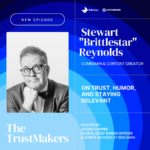Malcolm Gladwell’s “The Tipping Point” once offered a seemingly foolproof formula for viral success: find the right influencers, craft a sticky message, and watch your idea spread like wildfire. But in 2025, in a world fractured by social media echo chambers and bombarded by algorithmic noise, has that formula become obsolete? Even Gladwell himself has revisited his original thesis, most notably in his recent book “Revenge of the Tipping Point,” questioning the ease with which we can truly understand and influence others.
Clayton Ruebensaal, Chief Creative Officer of Comcast, grappled with this very question in a recent conversation with Axios media reporter Kerry Flynn. Their pre-SXSW session during Converge in Austin, a deep dive into the challenges of modern marketing, revealed that while the core principles of influence endure, the path to cultural contagion has become far more complex, demanding a new level of strategic precision and creative ingenuity.
South by Southwest: A Microcosm of the New Media Landscape
Ruebensaal, a veteran of the creative ranks was both excited and unsure of who and what he’d find at South by South by Southwest, before experiencing its transformative power firsthand. . He highlighted the event’s unique ability to bring together a diverse range of voices, from educators and tech experts to movie makers and marketers, creating a microcosm of the fragmented media landscape that brands must now navigate.
“It’s the most inspiring event I’ve ever been to,” Ruebensaal declared, emphasizing the value of networking and creative expression that South by Southwest fosters, a space where diverse perspectives collide and new ideas are born.
From Explosive Growth to Strategic Precision
Ruebensaal argued that the media landscape has undergone a seismic shift since Gladwell’s initial exploration of tipping points. “In 1996, if you got your brand into a major publication, the results were explosive,” he recalled. “Now, there’s thousands of outlets, thousands of channels. It’s like going from checkers to chess.”
This explosion of media channels has made it far more challenging to achieve a single, decisive “tipping point.” Instead, Ruebensaal suggested, marketers must now focus on identifying and activating multiple, smaller “veins” of influence, targeting niche audiences with precision and relevance.
Finding Your Unique Story
Ruebensaal offered a compelling example of how Comcast is leveraging data to connect with customers in a more meaningful way. By recognizing that most mobile phone users spend the majority of their time connected to Wi-Fi, Comcast is positioning itself as the “Wi-Fi expert” rather than simply another cellular provider.
“We’re not the phone guys,” Ruebensaal explained, emphasizing Comcast’s unique ability to provide seamless connectivity in the places where customers spend most of their time. This insight, rooted in data but driven by a clear understanding of customer needs, allows Comcast to differentiate itself in a crowded market.
Breaking Down Barriers to Multicultural Marketing
Ruebensaal also highlighted the potential of AI to help marketers overcome traditional barriers to multicultural marketing. “I’m never going to have enough staff to really do a good job” of targeting diverse audiences, he admitted. But with AI, “I might get to the place where I could say, I will have the tools to be able to do take my unique strategy, take my great marketing tools and apply that to [niche communities] in a way that will be relevant to them.”
The Call to Action: Embrace Creativity and Connection
Ultimately, Ruebensaal’s message is one of both caution and optimism. While technology offers powerful new tools for reaching audiences, it’s essential to remember the core values that have always driven successful marketing: creativity, authenticity, and human connection.
“If you want people to be interested, do something interesting,” Ruebensaal declared, urging marketers to move beyond mere data analysis and embrace the power of imagination and innovation.
In the age of AI and fragmented media, the challenge is not to replicate the “tipping point” of the past, but to forge new paths to influence, crafting compelling stories, building genuine relationships, and embracing the power of human creativity to break through the clutter and spark cultural contagion in a world that is more complex and unpredictable than ever before.











